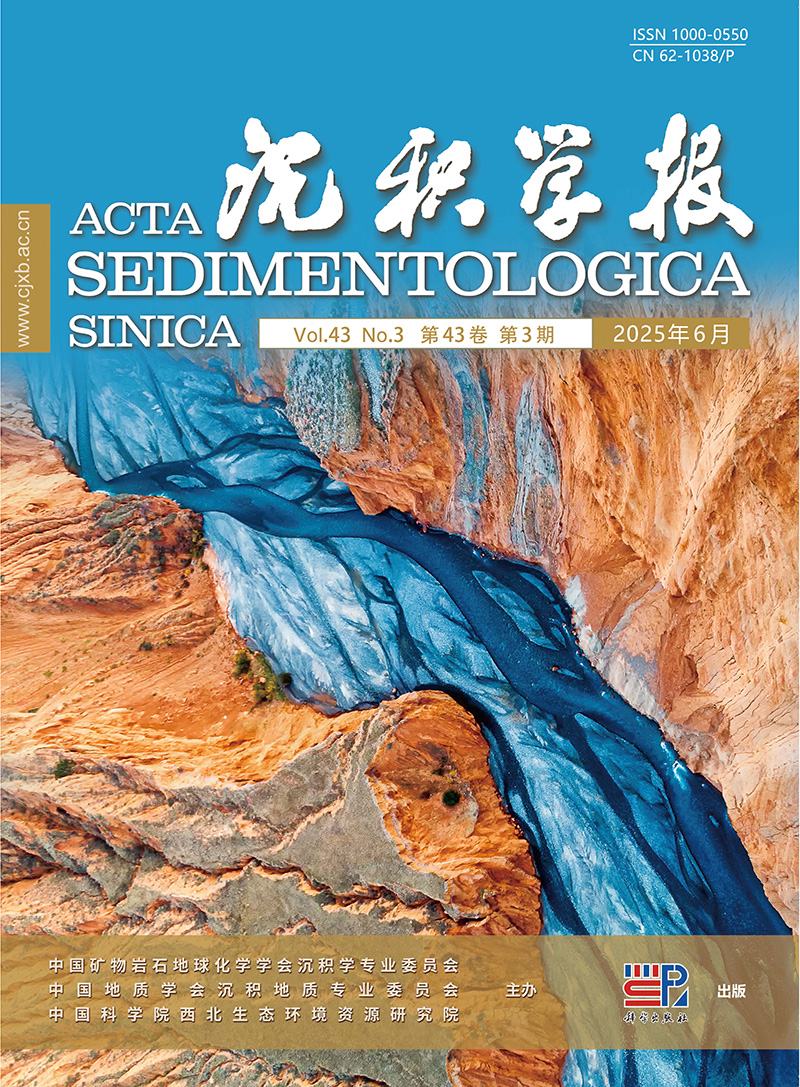HTML
-
页岩油是指赋存于富有机质页岩层系中的石油,一般无自然产能或低于工业石油产量下限,需采用特殊工艺和技术措施才能获得工业石油产量[1⁃3]。四川盆地下侏罗统主要发育东岳庙段、大安寨段和凉高山组二段(凉二段)3套黑色页岩[4]。其中大安寨段黑色页岩最为发育,是侏罗系页岩油勘探目的层之一。大安寨段油气勘探始于1958年,目的层段为介壳灰岩段(图1b),以寻找裂缝—孔隙型油藏为目标,先后发现了公山庙、莲花、金华、中台山与莲池五个油田,累计产油432.58×104 t[6]。2019年以来,开始针对大安寨段中部黑色页岩进行页岩油勘探,但多口井测试产量均较低,有利层段不落实。

Figure 1. Stratigraphic histogram and sedimentary facies distribution map of the Da’anzhai member in Sichuan Basin (modified from reference [5])
早侏罗世四川盆地为典型的陆内坳陷湖盆[7],大安寨段沉积于淡水湖泊环境,缺乏陆源粗粒碎屑的注入,发育泥页岩与介壳生物灰岩混积沉积[8⁃9]。前人对大安寨段岩石类型、沉积相[10⁃11]及致密油储层特征[12⁃15]等方面开展了大量相关研究,但这些研究关注的重点是作为致密油储层的介壳灰岩,对半深湖—深湖区页岩层系中各类岩性的垂向序列、互层规律及页岩油的源储品质关注较少。目前,大安寨段页岩油储层岩相组合的划分方案虽然较多,但一般都以各类互层岩性的厚度作为参考标准[16⁃18],未考虑沉积特征及源储配置关系。
本文选取川东北地区达州铁山金窝(107.3741558° E,31.2299147° N)、重庆梁平福禄镇(107.9100464° E,30.6284299° N)大安寨段野外露头为研究对象(图1a),开展薄片、X射线衍射全岩、有机地球化学等测试,划分页岩层系的岩相类型,总结不同岩相垂向序列,基于岩相序列开展页岩油源储配置分析,结合首次发现的页岩油油苗产出特征,为大安寨段页岩油有利层段的优选提供参考依据。
-
研究区位于四川盆地东北部,其构造位置属于川东高陡断褶带,发育了一系列东北—西南向延伸和隔挡式分布的大型复背斜和复向斜,构成了现今川东地区“隔挡式”的构造格局。
晚三叠世,在印支运动的影响下,四川盆地演化逐渐为陆相盆地,盆地四周为龙门山古陆、大巴山古陆、康滇古陆及雪峰山古陆[19⁃21]。早侏罗世为稳定的淡水湖泊沉积,发育自流井组和白田坝组,二者为同期异相关系。自流井组由下至上可分为珍珠冲段、东岳庙段、马鞍山段及大安寨段。其中珍珠冲段及马鞍山段发育泥岩夹细砂岩、粉砂岩,东岳庙段和大安寨段主要发育介壳灰岩和泥页岩。
大安寨段沉积期盆地周缘构造活动减弱,缺乏陆源碎屑供给,造成盆地坳陷速率大于沉积速率,最终导致四川盆地侏罗系最大湖盆的形成[19]。平面上川中—川东一带广泛发育半深湖—深湖亚相,介壳滩呈环状围绕半深湖分布[8⁃9](图1a)。大安寨段地层厚度一般介于60~110 m,根据岩性特征,可进一步划分为大一、大二和大三3个亚段(图1b)。大安寨段沉积期湖盆经历了一个完整的湖侵—湖退旋回,其中大二亚段为最大水进期,黑色页岩最为发育。
-
基于达州铁山金窝剖面、重庆梁平福禄镇剖面大安寨段野外及薄片资料,考虑成分、粒度将该地区大安寨段页岩层系岩相类型划分为灰岩、泥页岩和粉砂岩—砂岩3类。其中灰岩根据结构和组分,泥页岩根据颜色和成分进一步细分,共划分出介壳灰岩等6亚类及若干小类,各类岩相特征如下。
-
根据颗粒和灰泥含量可细分为介壳灰岩、泥晶介壳灰岩和含泥/泥质介壳灰岩(图2a,b)。介壳灰岩颗粒含量90%以上,以双壳类壳体为主,壳厚0.2~0.8 mm,壳长2~10 mm,偶见少量腹足类、介形类和轮藻,生物种群具有分异度低,丰度高特征。介壳平行叠置排列,形态完整,玻纤结构,为安静环境下介壳原地或近原地自然分解堆积而成。介壳间泥晶方解石含量大于10%时形成泥晶介壳灰岩,也可以充填泥质(>5%)形成含泥或泥质介壳灰岩。其中泥质介壳灰岩多以薄层或纹层出现,多见于相对低能的滩翼沉积。
-
介屑灰岩中的颗粒仍以双壳类为主,但壳体保存不完整,破碎或杂乱排列,分选差。介屑间泥晶方解石和泥质含量更高(图2c~e)。介屑灰岩厚度一般达数厘米且横向不稳定,与下伏地层突变接触。破碎介壳、排列杂乱、碎屑间含量较高的泥晶方解石或泥质反映了介壳被改造或搬运,突然卸载以及缺乏淘洗的沉积过程,多为重力流产物[8⁃9]。
-
常见于大一、三亚段,多由介壳灰岩或介屑灰岩强烈重结晶形成,手标本呈褐色(图2f),镜下方解石晶体直径0.1 mm~2 cm,强烈的重结晶使得介壳形态模糊不清(图2g)。泥质含量极低,说明为持续淘洗的高能环境产物,一般形成于滩核,厚度数厘米至数米,变化较大(图2f,g)。
-
泥晶灰岩类中的灰泥含量大于50%,介壳及泥质含量低(图2h)。根据介壳含量,将该类岩相分为含介壳泥晶灰岩、介壳质泥晶灰岩和泥晶灰岩3种类型。颗粒主要为双壳类或介形类,其中介形虫壳小且薄,双壳壳体一般杂乱分布,壳体多不完整,晶粒结构,层厚一般10~20 cm。
-
泥页岩是大安寨段主要岩石类型之一,根据颜色、介壳及粉砂质含量,可划分为灰黑色页岩、灰黑色含介壳/介壳质页岩,紫红色泥岩和灰绿色粉砂质泥岩。
黑色页岩:多见于大二亚段、大一亚段下部,质纯,基质中介壳含量低,但常夹介壳纹层或方解石充填的裂缝(小于1 cm,图3a),矿物类型以黏土为主,其次为石英,钙质含量极低,滴酸不起泡,有机质含量一般介于0.7%~2.0%,厚度为0.1~1.5 m,黑色页岩多形成于半深湖—深湖相的安静低能还原环境。

Figure 3. Typical field outcrop and microscopic photos of shale and siltstone⁃sandstone in the Da’anzhai member, northeast Sichuan
灰黑色含介壳/介壳质页岩:纵向上常分布于灰黑色页岩和介壳灰岩之间(图3b),介壳含量较高,一般大于10%,介壳个体保存完整,多为双壳类壳体。单层厚度变化较大,一般几厘米至几十厘米,厚者可达1.1 m,有机质含量较灰黑色页岩低,一般介于0.5%~1.0%,形成于安静、低能环境,水体略浅于前者,多为介壳滩与半深湖过渡区沉积。
粉砂质泥岩:多见于大三底部或大一上部,粉砂质含量较高,灰色或灰绿色(图3c),含少量介壳,介壳破碎不完整(图3d)。形成于靠岸的浅湖区,水浅且富氧,水动力条件强于灰黑色页岩。
紫红色泥岩:多以薄层(小于10 cm)形式出现于灰黑色页岩、灰黑色含介壳/介壳质页岩中(图3e,f),质纯且无粒序变化,与上下突变接触。另外,在薄层介屑灰岩层界面附近也观察到1 cm左右的紫红色泥岩。页岩颜色一般与碳含量以及铁的氧化有关,随着Fe3+/Fe2+比值增加,页岩颜色由绿灰色过渡为紫色再到红色[22]。这类薄层紫红色泥岩可能为浅水氧化区泥质沉积物在重力流作用下搬运至深水区卸载沉积形成,也可能是泥岩与底层氧化水长时间接触形成。
-
粉砂岩—砂岩主要分布于大一亚段,厚度一般小于1 m,可识别出重力流砂岩和浅湖滩砂。前者杂色、灰绿色,铁山剖面发育厚度为60 cm,与下伏地层突变接触,含杂乱排列的介壳碎屑(图3g),碎屑粒径多为粉砂—细砂级,分选较差,杂基含量高,甚至超过15%。浅湖滩砂多为薄层—中层灰绿色细砂岩(图3h,i),层状分布,分选较好,可见生物扰动构造,一般出现于大一亚段上部。
2.1. 介壳灰岩
2.2. 介屑灰岩
2.3. 结晶灰岩
2.4. 泥晶灰岩
2.5. 泥页岩
2.6. 粉砂岩—砂岩
-
在海相沉积中,由于碳酸盐沉积物的堆积速率快,因此其沉积物往往反复多次地达到并超过海平面,形成多个向上变浅的岩相序列。这种厚几十厘米至几米的向上变浅序列被认为是高频率海平面变化旋回的产物,又叫“米级旋回”[23⁃25]。Goodwin et al.[24]于1985年提出用间断加积旋回(Punctuated Aggradational Cycles,简称PAC旋回)机制来解释地层堆积模式。PAC旋回是一种在地层记录中普遍存在的单一过程所代表的周期性发生的事件的产物。野外剖面及岩心观察显示,大安寨段湖相页岩—介壳灰岩混积层系中同样发育类似的向上变浅的岩相序列。本次研究在浅湖、半深湖—深湖环境中共识别出6种向上变浅的分米级—米级的岩相序列(图4,5)。
-
主要分布于大二亚段的中部,下部为黑色页岩,含少量纹层状(单层厚度小于0.5 cm)不连续的介壳灰岩,向上渐变为灰黑色介壳质页岩,介壳分散分布。该序列沉积于半深湖—深湖环境(图5),早期缺氧环境,沉积黑色页岩,介壳含量低,后期湖平面下降,水体变浅且氧含量增加,底栖双壳类生物逐渐增多。
-
该序列常见于大二亚段,下部中厚层黑色页岩向上过渡为黑色页岩与纹层、薄层状介壳灰岩互层。介壳灰岩泥质含量高,与页岩突变接触,介壳壳体大小混杂,杂乱—半平行排列,横向厚度不稳定,具有重力流沉积特征。该序列一般形成于半深湖环境,且靠近介壳滩区域,浅湖相介壳滩为重力流提供物质来源。
-
常见于大一亚段下部和大三亚段上部,由下部黑色页岩、黑色页岩夹纹层或薄层状泥质介壳灰岩,向上变为中层介壳灰岩。该序列下部黑色页岩形成于半深湖缺氧环境,少见介壳。上部中层介壳灰岩为薄层介壳滩成因,其顶底泥质含量较中部重,具有复合粒序特征。
-
见于大一亚段中部,发育程度低。下部页岩呈灰色,深灰色;上部灰色薄层泥晶灰岩、瘤状泥晶灰岩,含少量介壳,厚度介于10~40 cm,夹2~3层1~3 cm薄层泥岩。该序列为低能浅水灰坪—浅湖泥岩沉积,瘤状灰岩可能为干旱炎热环境产物。
-
一般见于大一和大三亚段。下部偶见薄层页岩,中部薄层—中层灰色介壳灰岩,泥晶胶结,泥质含量低,但介壳未重结晶,上部为厚层褐色块状结晶灰岩。该序列形成于浅湖相介壳滩沉积,反应介壳滩的滩翼逐渐演化为高能滩核。
-
序列下部为泥质介壳灰岩或泥晶介壳灰岩,厚度介于10~50 cm,向上过渡为灰绿色的粉砂岩、粉砂质细砂岩,杂基含量高,含介壳碎屑。该序列形成于浅湖相,介壳滩向陆一侧区域。随着水深变浅,浅湖介壳滩逐渐演化为滨浅湖相粉砂岩/细砂岩。
3.1. 页岩—含介壳/介壳质页岩
3.2. 页岩—纹层/薄层介壳灰岩
3.3. 页岩—中层介壳灰岩
3.4. 页岩—瘤状泥晶灰岩
3.5. 薄层页岩—介壳灰岩—结晶灰岩
3.6. 介壳灰岩—粉砂岩/细砂岩
-
在岩相序列划分基础上,对大安寨段页岩油的源储品质进行评价(图6)。梁平福禄镇剖面黑色页岩厚度、总有机碳及热解分析显示。

Figure 6. Statistics of shale thickness and total organic carbon (TOC) of six lithofacies sequences from the Da’anzhai member in the Fuluzhen section
(1) 单个序列中序列①~③的黑色页岩最厚,平均厚度分别为1.66 m,1.15 m和1.23 m,而序列④、⑤只有0.49 m和0.21 m,序列⑥不发育黑色页岩(图6a)。
(2) 累计厚度:序列③黑色页岩的累计厚度最大,如福禄镇剖面共发育26.42 m黑色页岩,其中序列③黑色页岩的累计厚度11.06 m,占42%,其次为序列①,厚6.62 m,占25%,序列②为4.59 m,占17%,序列④、⑤分别为2.45 m和1.52 m,占比9%和6%(图6b)。
(3) 有机碳含量及纵向变化:黑色页岩较为发育的序列①~③,平均TOC含量分别为1.42%,1.31%和0.99%,而序列④、⑤为0.65%和0.38%(图6c)。纵向上,单期序列内部黑色页岩的有机碳含量具有下高上低的趋势,TOC随介壳含量的增加逐渐减少(图7)。

Figure 7. Vertical variation of organic carbon content within single lithofacies sequences of the Da’anzhai member
(4) 有机质类型:热解数据显示,大安寨段有机质类型以Ⅱ、Ⅲ型为主,含少量I型。I型和Ⅱ型有机质分布于序列①~③中,序列④、⑤以II、III型为主。
-
本次研究结合前人成果,对6种岩相序列页岩油的储集性能进行了评价。新鲜岩心孔隙度测试显示,大安寨段页岩孔隙度最高,平均为5.69%,介壳灰岩平均为3.27%[14],随介壳含量增加,孔隙度逐渐降低。本次补充了野外剖面介壳灰岩、泥晶灰岩、结晶灰岩以及粉砂岩的孔隙度分析。结果显示,介壳灰岩孔隙介于2.5%~4.21%,平均为3.87%,泥晶灰岩孔隙度介于1.22%~3.21%,平均为1.98%,结晶灰岩介于2.1%~3.59%,平均为2.91%,粉砂岩介于0.69%~2.94%,平均为1.32%,测试结果略高于岩心样品,但趋势一致(图8)。

Figure 8. Porosity distribution map of rock types in the Da’anzhai member (core data from reference [14])
野外及岩心的孔隙度测试显示,页岩孔隙度高于灰岩和粉砂岩。但针对大安寨段页岩段的水平井压裂测试并不理想,黑色页岩孔径小、纹层不发育、渗透率低,页岩油的可动性差可能是重要原因。因此,寻找储集条件较好的灰岩夹层或裂缝层,是后期关注的重点。
野外观察发现介壳灰岩发育不同密度的节理缝。节理类型以剪节理为主,产状稳定延伸远,节理面平直光滑,时有擦痕,多为未充填/半充填,常组成共轭X型节理系。节理一般分布于介壳灰岩中,部分延伸至相邻的介壳质泥岩或泥质介壳灰岩中,延伸距离短。
野外露头大量统计显示节理密度与介壳灰岩厚度呈反比(图9),薄层介壳灰岩节理往往密集发育,最大可达0.46条/cm。随着厚度增加,节理密度呈指数快速下降,大于20 cm之后,节理发育程度极低(≤0.05条/cm)。因此,薄层及部分中层(10~20 cm)的介壳灰岩储集性能更好。
4.1. 烃源条件
4.2. 储集条件
-
大安寨段岩心及本次野外样品的物性测试均显示页岩孔隙度好于介壳灰岩。已有数据统计显示,孔隙度与黏土含量呈正相关,与碳酸盐含量呈负相关,与有机质基本不相关[14]。黏土晶间孔虽然孔径小但密集发育(图10a),贡献了主要的储集空间,因此孔隙度与黏土含量正相关;介壳灰岩中方解石晶间孔形成于埋藏成岩过程中的重结晶作用,孔径大但是数量少(图10b),占孔隙体积比例小[14],因此随碳酸盐含量增加,孔隙度减小。干酪根处于高成熟生油阶段(Ro小于1.2%),尚未进入大量有机孔发育阶段,加之有机质的吸附和溶胀作用[26],有机孔发育程度低,同时大安寨段黑色页岩有机质含量偏低(一般1%~2%),因此有机质含量与孔隙度几乎没有相关性。

Figure 10. Scanning electron microscope (SEM) images of clay intergranular pores and shell calcite intergranular pores from the Da’anzhai member
由于大安段黑色页岩富含黏土,缺少纹层导致其渗流能力差,压裂测试效果不理想,并不是良好的页岩油储层。主要原因与页岩沉积环境有关:大安寨段沉积期湖盆为淡水、半咸水环境[10],不利于结晶方解石纹层的形成,导致纹理缝等高渗通道缺乏。缺乏陆源砂质供应,生屑滩持续发育,半深湖、深湖区多以富黏土页岩为特征,页岩黏土含量普遍高于45%,不利于压裂,因此黑色页岩主要作为优质烃源岩供烃。
-
大安寨段的灰岩类型主要为介壳灰岩,介壳是主要结构组分,介壳方解石晶间孔隙连通性较差,微裂缝的沟通对改善储渗能力至关重要[14,27⁃28]。
密集的节理可作为高效的储渗空间,共轭节理相互连通形成网状缝网,节理缝宽度多为微米级—毫米级,渗流能力强。节理一般垂直层面,在上覆地层压力下,容易保持开启状态,有效性好。节理也可作为黑色页岩与介壳灰岩的沟通通道,为埋藏期有机酸溶蚀提供通道。
手标本及荧光扫描资料显示,对于节理不发育的介壳灰岩,荧光较强区域主要分布于介壳灰岩—页岩界面附近(图11),介壳灰岩内部缺乏荧光显示,说明油气在介壳灰岩内的纵向运移是困难的,节理缝及两侧是野外油苗的主要赋存位置(图12)。前人利用荧光图像与单偏光融合技术分析了单个介壳[14],也显示荧光较强区域主要分布于介壳边缘以及介壳内部微裂缝如解理缝或破裂缝附近。因此,裂缝对页岩油储层储渗能力的改善至关重要。

Figure 11. (a)Fluorescence scanning photos of argillaceous shell limestone in the Da’anzhai member; (b)white light scanning photos of argillaceous shell limestone in the Da’anzhai member

Figure 12. Shale oil seepages distribution feature of the Da’anzhai member in the Tieshan section, Dazhou
沉积岩节理发育密度主要受控于岩性和地层厚度[29⁃31]。厚层介壳灰岩节理密度小,薄层介壳灰岩节理往往密集发育,有利于优质储集段的发育。
-
综上所述,大安寨段页岩油的优质烃源和优质储层是分离的,不同岩相序列源储差异较大。6种岩相序列中序列①虽然发育黑色页岩,但缺乏介壳灰岩,微裂缝不发育,储渗能力较差;序列②、③既发育黑色页岩,也发育介壳灰岩,且灰岩厚度较薄,节理发育,是有利的源储组合(图13);序列④~⑥发育介壳灰岩,但缺乏相邻的优质黑色页岩,这类岩相序列中的介壳灰岩若要富集油气,往往需要断裂沟通下部烃源以及天然气驱动石油运聚[32]。

Figure 13. Stratigraphy⁃sedimental⁃reservoir integrated histogram of shale oil in the Jurassic Da’anzhai member, Fuluzhen
上述认识与野外油苗分布特征一致。本次研究在新鲜垮塌的大安寨段大二亚段露头中,发现了大量的页岩油油苗(图12),特征如下。
(1) 纵向上油苗分布于大二亚段。主要出现于薄层、中层的介壳灰岩、泥质介壳灰岩中,属于②、③类岩相序列,而黑色页岩、含介壳页岩未见油苗。
(2) 野外页岩油苗多呈斑块状平行分布,出现于介壳灰岩节理面以及节理沟通的溶孔洞附近,有时可不规则侵染至相邻的介壳质页岩中,证明节理微裂缝的重要作用。
5.1. 岩石组分对页岩储集性能的影响
5.2. 微裂缝对优质储集段的影响
5.3. 优质源储与油苗分布关系
-
(1) 大安寨段为一套灰岩—页岩混合沉积层系,发育6种向上变浅的岩相序列:①页岩—含介壳/介壳质页岩、②页岩—纹层/薄层介壳灰岩、③页岩—中层介壳灰岩、④页岩—瘤状泥晶灰岩、⑤薄层页岩—介壳灰岩—结晶灰岩、⑥介壳灰岩—粉砂岩/细砂岩。
(2) 不同岩相序列的烃源岩与储层品质差异大。序列①~③黑色页岩最为发育,烃源品质最佳;单期序列内,黑色页岩TOC呈现向上递减趋势。页岩孔隙度高于灰岩和粉砂岩,但孔径较小、渗透率低。灰岩中构造裂缝(节理缝)发育,裂缝密度随单层厚度增加呈指数下降,薄层至中层灰岩发育的序列②~④具有更好的储集性能。
(3) 大安寨段沉积于淡水—半咸水环境,陆源砂质供应有限,黑色页岩富黏土矿物而贫石英碎屑,可压裂性差,主要作为优质烃源岩提供烃。发育微裂缝的介壳灰岩夹层,可作为页岩油气富集层段。综合评价认为,岩相序列②和③具有最优的烃源岩—储层配置条件,是页岩油勘探开发的有利层段。











 DownLoad:
DownLoad:











